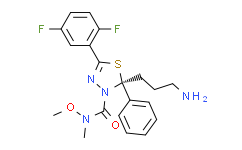| Cas No.: | 885060-09-3 |
| Chemical Name: | Filanesib |
| Synonyms: | (2S)-2-(3-Aminopropyl)-5-(2,5-difluorophenyl)-N-methoxy-N-methyl-2-phenyl-1,3,4-thiadiazole-3(2H)-carboxamide;ARRY-520;(2S)-2-(3-aminopropyl)-5-(2,5-difluorophenyl)-N-methoxy-N-methyl-2-phenyl-1,3,4-thiadiazole-3-carboxamide;ARRY 520 trifluoroacetate;ARRY520;Filanesib |
| SMILES: | NCCCC1(C2=CC=CC=C2)N(C(=O)N(C)OC)N=C(C3C(F)=CC=C(F)C=3)S1 |
| Formula: | C20H22F2N4O2S |
| M.Wt: | 420.48 |
| Sotrage: | 2 years -20°C Powder, 2 weeks 4°C in DMSO, 6 months -80°C in DMSO |
| Description: | Filanesib (ARRY-520) is a synthetic kinesin spindle protein (KSP) inhibitor with IC50 of 6 nM. |
| In Vivo: | Filanesib (ARRY-520) (10, 15, 20, 30 mg/kg, i.p.) is active in UISO-BCA-1 xenograft, and also superior to paclitaxel in mice bearing subcutaneous HT-29, HCT-116, MDA-MB-231 and A2780 xenografts. ARRY-520 is superior to docetaxel in the androgen receptor-negative prostate cancer xenograft model PC-3, and is also superior to docetaxel in the DU145 prostate xenograft model[1]. RPMI 8226 tumor xenografts are particularly sensitive to low doses of ARRY-520 (12.5 mg/kg, i.p.)[2]. ARRY-520 significantly inhibits tumor growth in HL60 and MV4-11 xenografts of SCID mice at concentrations of 27 mg/kg and 20 mg/kg, respectively[4]. |
| In Vitro: | Filanesib (ARRY-520) retains activity in multidrug-resistant cell lines. The EC50s of Filanesib (ARRY-520) for inhibition of proliferation of HCT-15, NCI/ADR-RES and K562/ADR cells are 3.7, 14 and 4.2 nM respectively. Filanesib (ARRY-520) (10 nM) blocks a majority of cells in mitosis with the monopolar spindle structure typical of KSP inhibition[1]. Filanesib (ARRY-520) (10 nM) induces mitotic arrest as judged by both increased phosphorylation of histone H3 (pHH3) and accumulation of cyclin B1 in four cells[2]. Filanesib (ARRY-520) and Paclitaxel exhibit the same cytotoxic effect on Type I and II cells. The GI50 at 48 h for Type II EOC cells is 0.0015 μM for ARRY-520. For Type I EOC cells, the GI50 at 48 h is > 3 μM for ARRY-520[3]. Filanesib (ARRY-520) (1 nM) induces significant G2M cell cycle block in OCI-AML3 cells at 24 hours[4]. |

 To enhance service speed and avoid tariff delays, we've opened a US warehouse. All US orders ship directly from our US facility.
To enhance service speed and avoid tariff delays, we've opened a US warehouse. All US orders ship directly from our US facility.




















